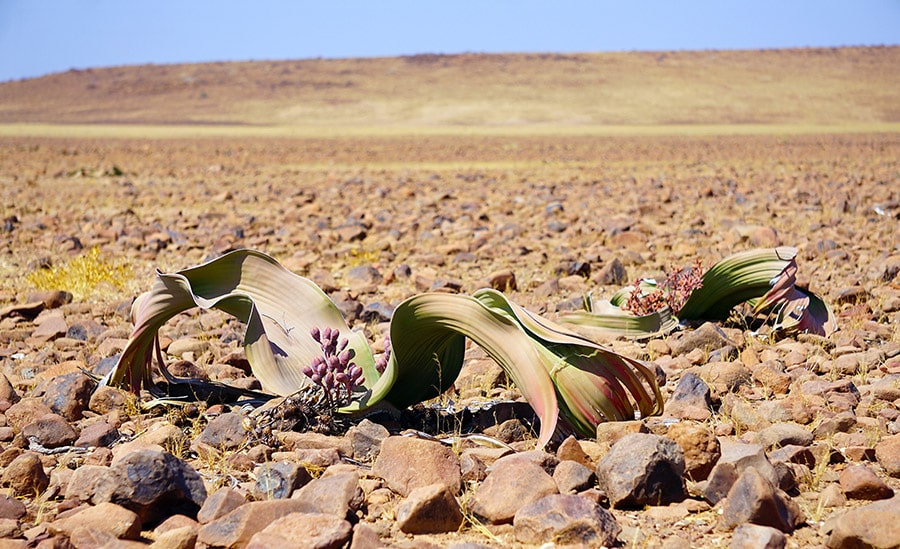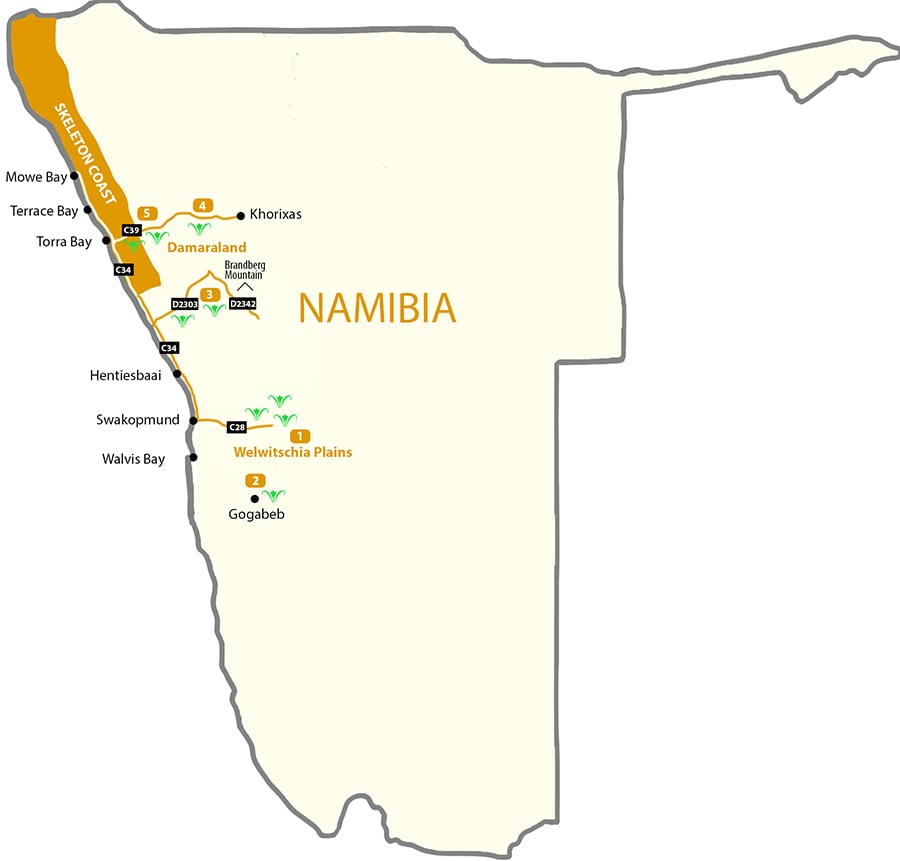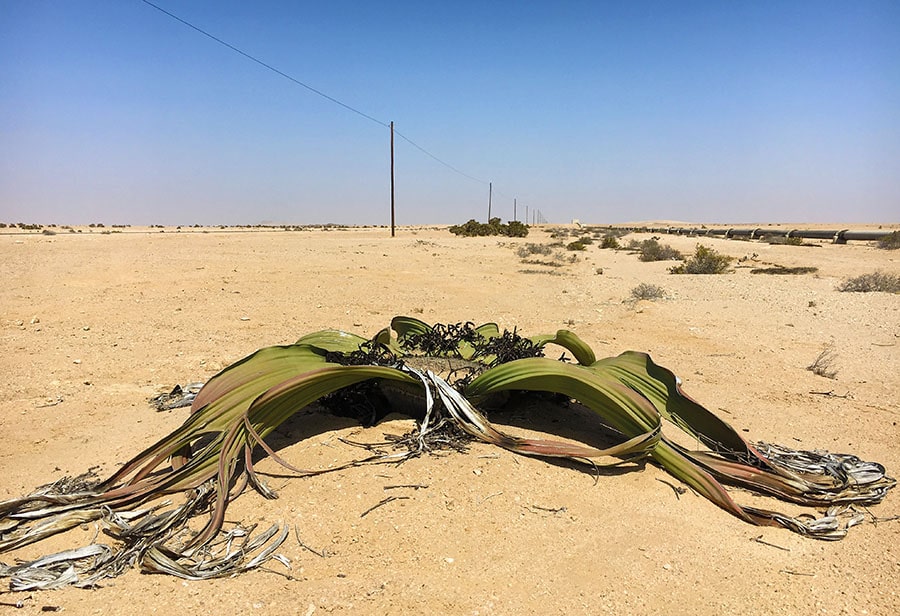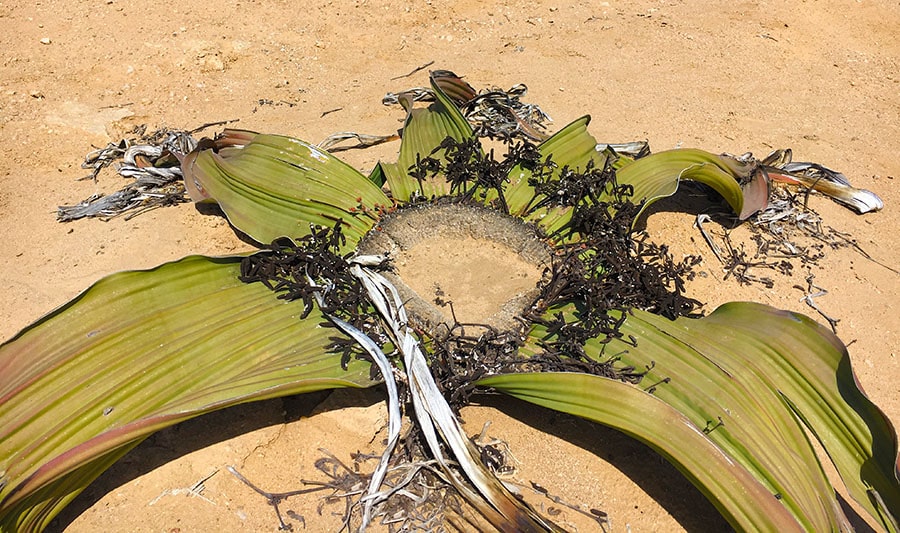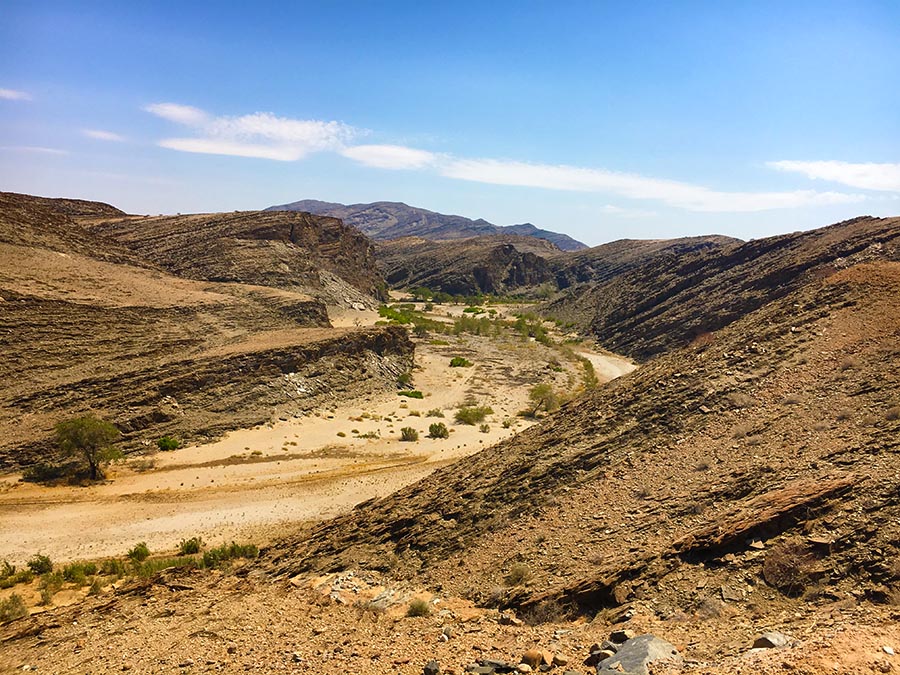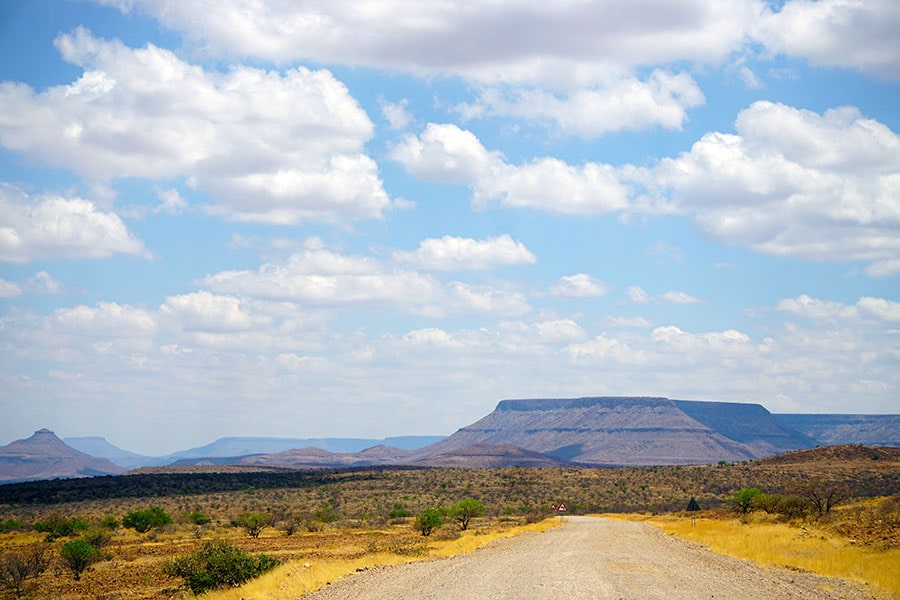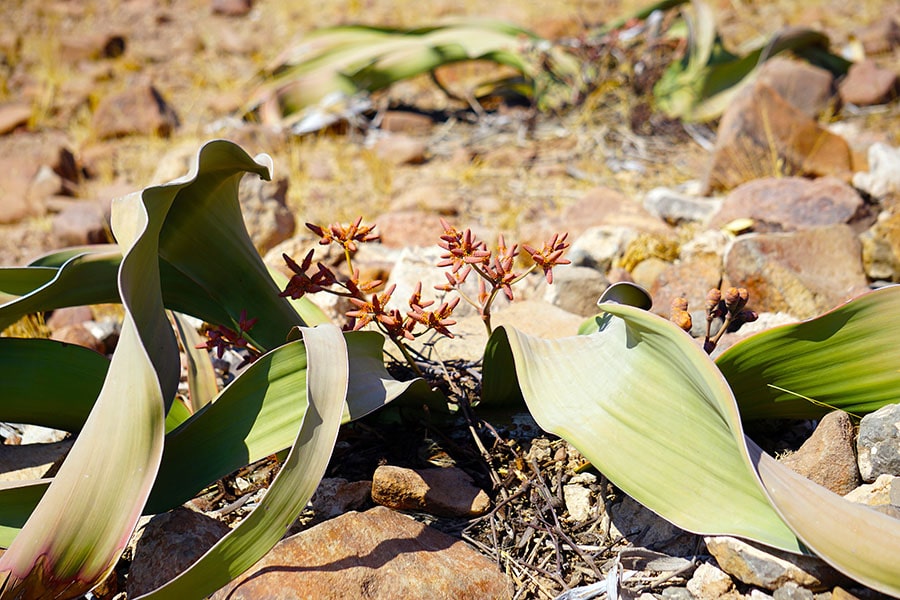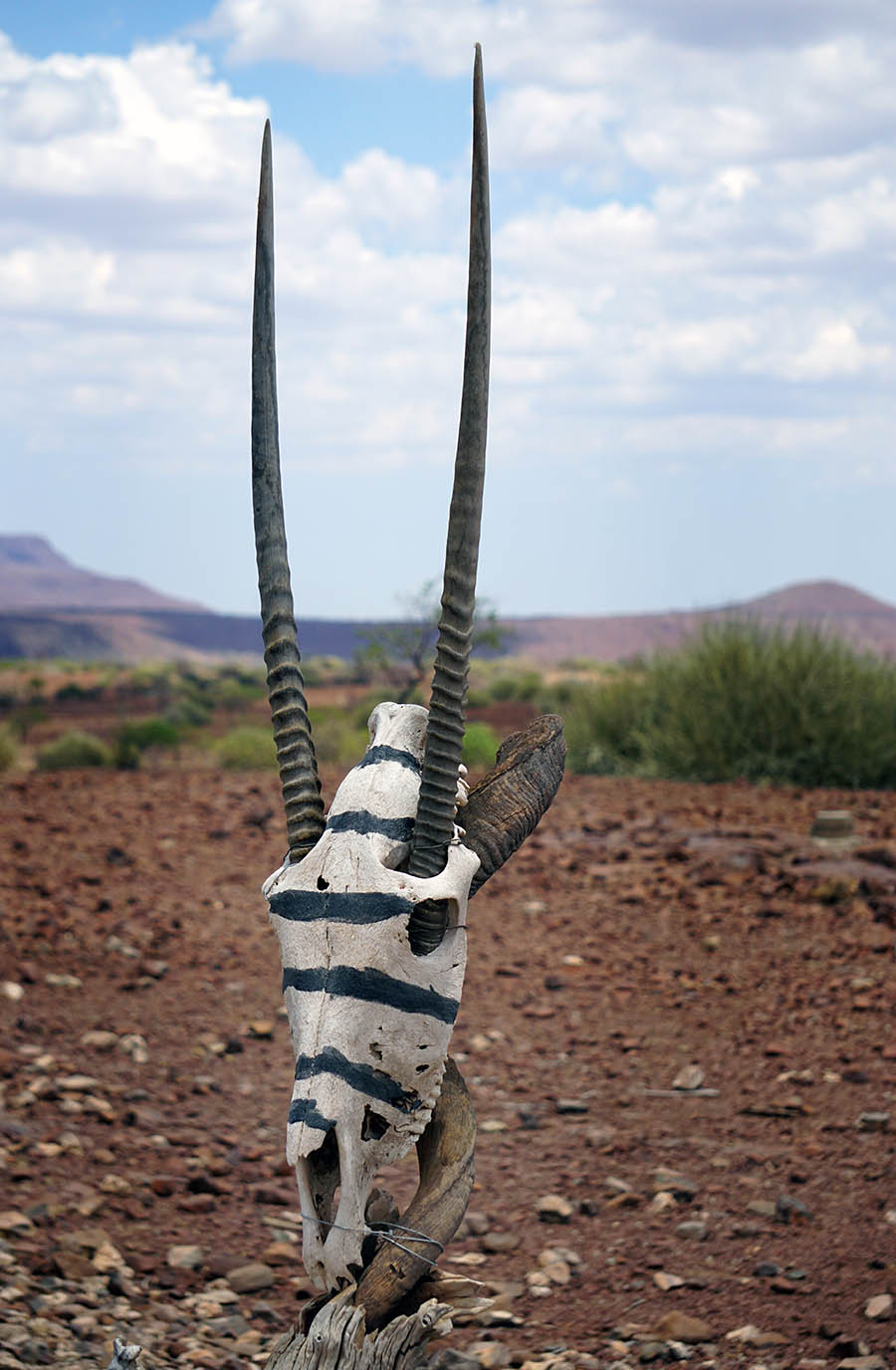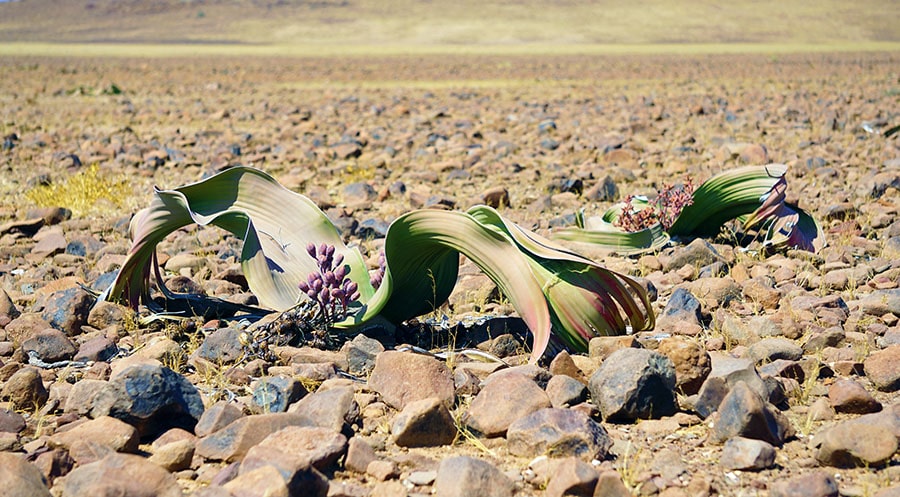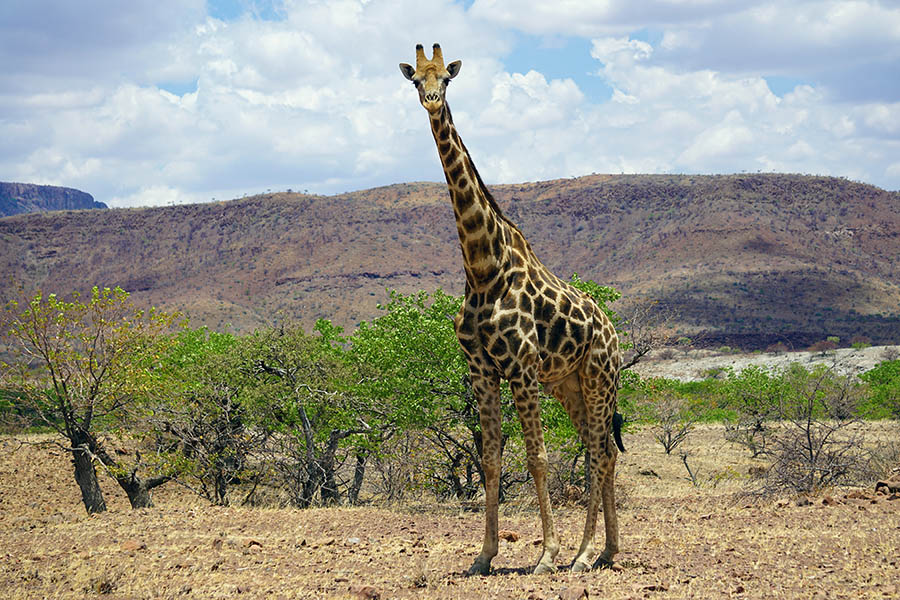The Welwitschia Plains near Swakopmund and the Coastal fog belt of Damaraland are the areas with most reported sightings of Welwitchia mirabilis since its discovery in Namibia. Below is an abbreviated map and detailed descriptions of 5 specific locations in Namibia, where you can find larger populations of Welwitschia plants in the wild. Most of them are based on our own sightings during the Unexpected Trip to Africa.
Discovery of Welwitchia mirabilis in Namibia
In September 1859, an Austrian botanist Friedrich Welwitsch made the first documented discovery of a new remarkable plant living on an elevated plateau near Cape Negro in Angola. He shared his findings with Dr. William Hooker, the director of the Royal Botanic Gardens, Kew at the time.
Shortly after, 500 miles south, Thomas Baines, an artist who was accompanying Dr. Livingstone on an expedition to the Zambezi River, drew several colored sketches of a big mysterious plant he found in the Namib Desert. Along with a few cones and leaves he collected, Baines sent his drawings of the “strange giant aloe” to William Hooker as well. This marked the official discovery of the “marvelous plant” Welwitschia mirabilis, in Namibia.
Today, you can see an oil painting created by Baines based on his original sketch at the Kew Library. Its caption reads “The Welwitschia mirabilis or Nyanka Kykamkop plant of Hykamkop, South West Africa. T. Baines. May 9 1861”.
Welwitschia Mirabilis Natural Range and Distribution
Welwitschia mirabilis is a regional endemic of the Coastal Namib Desert. Its natural range extends over an area of 150,000 square km along the southwestern coast of Africa from the Kuiseb River (the Tropic of Capricorn) in central Namibia to the Bentiaba River in southern Angola. Its preferred habitat appears to be hyper-arid gravel plains or gypsum-rich soils.
The prominent Swedish explorer of Namibia Charles Andersson was writing in his notes “It is most common about the lower course of the River Swakop”. He also mentioned that it was growing in “the ground of hard quartzose character, and generally near little ruts worn in the plain by running water in the rainy season”. In 1862, the first living specimen of Welwitschia mirabilis was planted “with its native soil in a flour barrel” and shipped with a mail-steamer to join the botanical collection at Kew.
Below are five best locations in Namibia to see a variety of wild Welwitschia mirabilis plants growing within distinct, but equally natural habitats (numbered as on the map above).
1. Welwitschia Drive
The location the explorer Charles Andersson was referring in his early notes is believed to be Welwitschia Plains (also called Welwitschia Flats or Welwitschia Fläche). It is the most popular and widely advertised site in the Central Namib Desert for viewing Welwitschia plants. Situated between the Khan and Swakop rivers, it is a part of the Namib-Naukluft Park and has an easy access both from Swakopmund in the west and Windhoek in the east.
A permit, which can be obtained in Swakopmund, is required to access the Welwitschia Plains. With this permit, you will also receive a hand-drawn map of the Namib-Naukluft Park containing the small section dedicated to the Welwitschia Drive.
The tourist route from Swakopmund through Welwitschia Plains is called Welwitschia Drive. The round trip is 160 km and takes about 3-4 hours to tour with stops. It is an arid and barren place, but the area by the Swakop river provides some shade and is equipped with picnic tables and even campsites for overnight stays if desired.
You can download and bring along the official “The Welwitschia Plains – scenic drive” brochure, which includes a map and descriptions of all “attractions” along the route. Look for 13 labelled stone beacons. At the end of the Welwitchia Drive at the turning point, markers 11 & 12 will indicate the highlight of the trip, a larger group of very special Welwitschia (some female and male plants are marked with respective signs).
The Swakopmund location along the Welwitschia Drive boasts the oldest known plant colony, some of which are of remarkable size. The two largest Welwitschias (both female plants) in existence are growing here. These are also the oldest living Welwitschia plants, with an age of 1500 years (as estimated by carbon dating).
Chris Bornman details the enormous size on these peculiar plants in his article “Welwitschia mirabilis: paradox of the Namib Desert”: “The two tallest plants known, the Husab Welwitschia and the Pforte Welwitschia are 1.5 m and 1.9 m from the base to crown, respectively. The latter plant occupies an area 9.1 m in circumference and its stem, measured along the terminal groove, has a circumference of 5.7 m”.
Local mining activities resulted in excavation of some old Welwitschia plants in the area. This facilitated a study of their root system and the water sources. It showed that, contrary to a belief, the tap root was not all that long and did not measure more than 3 meters. Based on these and other observations, it was concluded that Welwitschia plants cannot rely on access to the ground water at 50-75 m depth for water supply.
2. Mine Hope and Welwitschia Wash on Kuiseb River
The Tropic of Capricorn is the most southern frontier of Welwitschia mirabilis natural habitat range. This community of plants is little off the most popular tourist routes in Namibia, but it may be more accessible if you plan to visit the Gobabeb Research and Training Centre (GRTC). The Center, which is located about 120 km southeast of Swakopmund, has dedicated numerous studies of the Gobabeb population of Welwitschia mirabilis.
These plants are concentrated in tributaries of the Kuiseb River, 15 km (in the Welwitschia Wash) and 30 km (near the Hope Mine) from the Research Center. Apparently, you can make a reservation for your stay in the area by directly contacting the GRTC.
Welwitschia Plants of Damaraland
Unlike Welwitschia Plains near Swakopmund, the Welwitschia locations of Damaraland and the neighboring Skeleton Coast are not widely advertised. This may be because many of these places are more remote and some are notoriously difficult to get to. Below are the three areas in the Damaraland you might wish to explore in search of Welwitschia mirabilis.
3. Welwitschia of Brandberg and Messum Crater
Amid vast desert plains, 250 km north the Welwitschia Drive, there is a granite massif with Namibia’s highest peak, the Brandberg Mountain (2,573m). It is at the foot of this mountain, Willie Giess (a botanist who was mapping Namibian plant communities back in the 1970s) found the largest Welwitschia plants ever recorded. Reportedly, he described a plant with a stem height of 1.8 m and another one with a stem diameter of 4 m near the Messum Crater (a large volcanic depression in the ground) west of Brandberg. However, some publications indicate that those giants since then burnt down by the lightening fire.
Unique Welwitschia plants with extra leaves (3-4, instead the usual 2) were also reported around here by Dieter von Willert in 1993. Two distinct types of extra-leafed Welwitschia were described in “Can Welwitschia mirabilis have more than only two Foliage leaves?”.
The first type had an additional pair of opposite leaves breaking through the top of the stem (more than a dozen of these were found among the 300 plants examined). The second variety had a single additional leaf. A group of nature enthusiasts on a follow-up “expedition” to this area in 2001 confirmed these findings. You can read their own account in “Torn to Ribbons in the Desert”.
A check list of 490 vascular plants living in the area (including Welwitschia mirabilis), can be found in “The flora of the Brandberg, Namibia”.
The Brandberg and Messum Crater area is best accessible via D2342 and D2303, off the Skeleton Coast road C34. Both D-roads are in a relatively good condition and are passable by a 2WD (although renting a car with higher clearance is advisable in these parts).
This amazing travel blog describes an adventurous 3-day journey of a biker along the same route (albeit in opposite direction) D2342 and D2303. There are also numerous photographs of the area, including those of the Brandberg Welwitscha population.
Ugab River Rhino Camp near the D2342-D2303 junction is the only place in the area where you can camp. However, you can visit the area as a day trip from Hentiesbaai (if you start early) or better yet from Cape Cross on C34.
Driving along the northern section of D2303 over the Ugab River is not recommended for independent tourists even by a 4WD. It is easy to understand after you hear the story about a well-travelled Dutch couple, Jan Snel and Mieke Schrijver, who got lost in that remote Burnt Mountain region of Damaraland and ran out of fuel in the late April 2003. They were stranded there without water for over two weeks. By the time they were found, Jan Snel died of dehydration and his wife was barely alive.
4. Welwitschia on the Fringes of the Skeleton Coast
Welwitschia grow along roadside of C39 just before you exit the Springbokwasser Gate of the Skeleton Coast National Park (30km from the Atlantic Coast). Curious about other unique plants along this route? Read the Skeleton Coast Plants post.
As you continue along beyond the Gate, a scenic view over the gravel plains opens up with numerous additional opportunities to get spectacular local welwitschia plants in the frame with the mountains of the Great Escarpment as a backdrop. These plants are “fed” by the water provided by the Koigab River, which “runs” faithfully along the road.
If you keep driving for another 125 km on C39 (about 2 hours) from the Skeleton Coast National Park), you will be able to admire Welwitschia plans thriving in a different natural environment of the mopane savanna.
5. Welwitschia in Mopane Savanna near Khorixas
This unique population of Welwitschia plants grows along C39 west of Khorixas in Damaraland. The mean annual rainfall (150–200 mm) is significantly higher here than in the other Namibian Desert Welwitschia habitats described above. This is mopane savanna dominated by extensive grass cover, small shrubs and mopane trees.
If you are headed to see the Petrified Forest (45 km west of Khoraxis on C39), you won’t be able to miss the local Welwitschia growing there. They can be spotted rooted in sandstone right next to the 250 million years old fossilized pine trees, which are the major attraction of this site with the national monument status since 1950.

